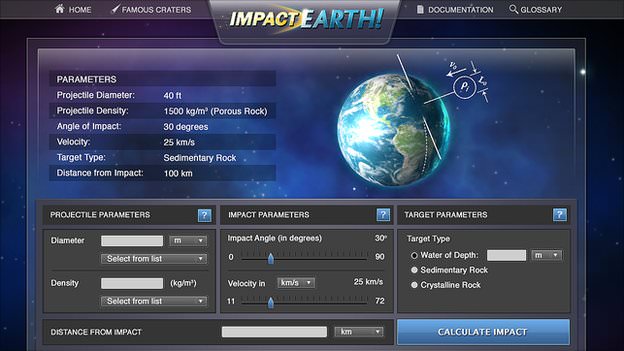[/caption]
A 20-km asteroid has just been predicted to hit Earth and you want to know if a. You should run for it, b. You should call Bruce Willis, or c. You can rest easy because your part of the world won’t be affected. All you have to do is input the parameters of the asteroid on the recently updated “Impact Earth” website, and you’ll find out everything about what an impactor will do to Earth, including an estimate of the size of the crater, how far away you’ll need to be in order to avoid being affected by the impact (and if that is possible), tsunami wave height, and other details of the subsequent disaster. The fun part is, you can simulate the destruction of Earth multiple times, without hurting anyone.
The original Impact Earth website was created in 2002 for use by NASA and homeland security. The new version, built in a collaboration between Purdue University and Imperial College London, is more user-friendly for the general public, as well as providing more visual details of an impact. Besides being rather fun to play around with, the website is highly educational about what a various sized impacts would do Earth, depending on if it hit ground or water.


Oh, fun!
Alas, the impact speed only goes to 72 km/s, so you can’t compute kinetic kill vehicles.
This was fun! Check out the parameters that i put in, and the results.
Diameter: 20km, Density: 1000000000000000000000000kg/m^3, Angle: 90 degrees
With a 72km Velocity
The results were: Transient Crater Diameter: 28893272207652 km ( = 17942722040951.9 miles )
Transient Crater Depth: 10216857216284.3 km ( = 6344668331312.56 miles )
Final Crater Diameter: 1.63386687696668E+15 km ( = 1.01463133059631E+15 miles )
Final Crater Depth: 11230.005 km ( = 6973.833 miles )
The crater formed is a complex crater.
LOL I think it clean punched a hole right through the earth.
Did you simulate a neutron star impact??? 😀
I’ve not managed to budge the Earth off it’s orbit or change its mass even colliding it with another Earth…
A funny I got was in one field it was telling me the balst wave would “distort” cars and that they would need repairs to run again…
While the Ejecta field told me I was just buried under 7 km of ejecta.
Lookingbeyond, I took your parameters…
AND BLEW UP THE EARTH!!!
The Earth is completely disrupted by the impact and its debris forms a new asteroid belt orbiting the sun between Venus and Mars.
100 percent of the Earth is melted
Depending on the direction and location the collision, the impact may totally change the Earth’s rotation period and the tilt of its axis.
Depending on the direction and location of impact, the collision may cause a change in the length of the day of up to 43585.915 hours.
The impact shifts the Earth’s orbit totally.
Not the length of day change…
I don’t know how this program works, but probably not via adaptive mesh refinement smooth particle hydrodynamics simulations… 😛
Lol Yes,
Just wanted to see what it would say for the results, if something small and ultra dense was put into the values.
Makes me scared now…. :O
I’m going to start dreaming of killer rouge neutron stars coming our way.
😉
Fun! My 1,000 ft, hard rock’s shock wave killed me even though it impacted 50 miles away! THEN the Tsunami washed it all away…
It is interesting that for 50-100 meter impactors, which is most likely what we might realistically face, these have a frequency of around 500 to 1000 years. This is in the size range the 1905 impact in Russia. This is one reason I don’t lose a lot of sleep over asteroid impacts.
LC
Hehe, my 10m debris @ neutron star density (3,7*10^17) striking @ 40km/s @ only 10 degrees angle kills us all 😀
Beware 🙂